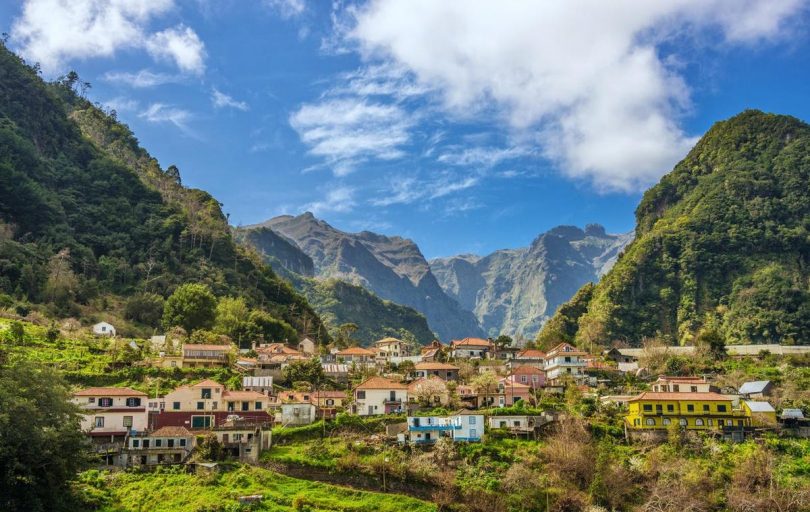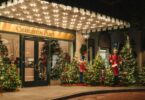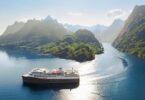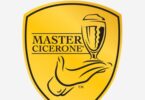Rural Madeira landscape.
‘A man’s culture is essentially the sum of his memories,’ wrote José Manuel Melim Mendes in his bilingual book Memories of Porto Santo and Madeira. If so, the collective mental culture of Madeira island is surely one of kaleidoscopic richness: aquamarine waves, violet hydrangea, emerald forests and purple cumulonimbus. Here be sounds of cracking shorelines, whale songs and wind whistled peaks.
Madeira is an oddly unique geographical and cultural blip—a rich little universe of rough mountains and lush slopes slapped by Atlantic breakers off the coast of Africa. Locals revere their flower, organ, philharmonic and wine festivals; annually they parade a trove of impeccably kept family heirloom classic cars throughout the capital city. Their cuisine is generally healthy and rich; their local air is fresh, humid and sweet, and birdsong lights up their sky.
Fishing boats at Câmara de Lobos on the south coast of Madeira
The island of Madeira is about three times the size of the U.S. island of Nantucket, twice the area of the British Isle of Wight and slightly larger than Singapore island. Together with the islands of Porto Santo and Desertas and the Selvagens—Madeira forms an autonomous region of the country of Portugal. It sits 550 miles [870 kilometers] west of the Moroccan city of Casablanca—the same distance as from Sacramento to San Diego, or from Geneva to Berlin. The climate is semi-tropical.
The Portuguese word madeira means wood, because forests coated the island when navigators first settled its shores in the 15th century. Safe, beautiful and with a balmy climate, this mountainous island is a joy to visit.
Diving off coast of Porto Santo, part of the Madeira archipelago
Yet Madeira was not always accessible.
Until recently, exploring the island was arduous. This mountainous land with rugged coasts had unsafe roads and few ports. Residents hiked over heinously steep and rocky mountain trails to visit neighbors in adjacent valleys. Today, the nation’s road network resembles that of Switzerland—with ample tunnels and elevated highways. This engineering allows rapid travel through—instead of over—peaks, and moving from the southern to the northern coast is now facile. The two longest road tunnels are each over 1.9 miles [3 kilometers] long.
Thirty-five-year-old Dinarte Fernandes is the mayor of the town of Santana on the northern coast. He believes that Madeira is unique because of the combination of landscape, people and their experiences. He spoke about past challenges to development.
Dinarte Fernandes – Mayor of Santana, Madeira
‘We are a small island. However, topography stopped our development. Forty years ago—everything was very different. I know older people who never visited the capital city of Funchal. My father grew up in a thatched roofed house with 11 children, and my grandfather would spend one day each week walking to Funchal to sell eggs. In 1986—when Portugal joined the European Community—that did everything for us.’
‘Everything’ was providing the island with access to development funds.
Despite recent transportation engineering, mountain roads still criss-cross Madeira (within the city of Funchal, one road averages a 25% slope). Many such steep and twisted routes pass through lush landscapes with terraced agriculture—including sugar cane and sweet potato fields—or wild growth, such as kapok and fig trees. Vistas include tropical greenery, blue skies and jagged coastal cliffs. Some hillside homes still lack driveways due to steepness of land on which they are sited. Irrigation channels known as levadas—originally dug to transport water from the rainy northwest to the drier southeast—are still used, and their banks serve as pathways for hikers and trail runners.
Atlantic ciew from Quinta do Furao Restaurant near Santana, Madeira
Created five million years ago from volcanic explosions, the island remained uninhabited by humans until Portuguese navigators started visiting in 1419. This was during the country’s era of exploration, when sea captains such as Henry the Navigator, Bartolomeu Dias, Vasco da Gama and Ferdinand Magellan sailed the world.
The island has few sandy beaches (with black sand) and ample forests. Flat regions are rare; when the Funchal airport runway was expanded, part of it had to be placed on elevated piers above an existing shipyard. Such topography, however, provides vistas—hence there are seven scenic cable cars on the island’s mountainsides. Typical views include misty serrated ridges cloaked in vegetation.
The capital of Madeira is Funchal, where roughly half the island’s quarter million residents live. Its road medians typically include palm trees, lush grass or flowers, and residents relish walking on the wide sidewalks, or gathering to share coffee on outdoor restaurant patios. Many buildings are pink—a color that during a past era signified that the owner was wealthy.
Funchal city at night is lively and lovely—a sort of smaller and flatter version of Lisbon. The main street—Avenida do Mar—is known as the city’s own Champs-Élysées with its ample stores, café culture, wide sidewalks, spewing fountains and artistic illumination. Locals dress with characteristic Madeiran graceful chicness before they parade out in the evening across tiled and cobbled boulevards.
From the city you can drive up a steep road to almost 2,000 feet elevation [589 meters] to Cabo Girão viewpoint. Gaze out from there at stark cliffs and rocky peaks that plunge into rough coastline shores buttressed by a turquoise ocean.
View from Cabo Girão outside the capital city Funchal
Or, drive six miles [nine kilometers] west to the coastal fishing town of Câmara De Lobos (named after monk seals that once roamed its shores), where British Prime Minister Winston Churchill used to visit and paint oil images of village scenes. This is also where villagers—at locales such as Bar Filhos D’Mar—knock back a 40% to 60% fruity local liquor known as poncha—typically made with citrus fruit, rum and honey. Originally medicinal, this elixir was concocted by fishermen to soothe throats irritated by sea spray. Today, the drink is often paired with a snack known as tremoços—lupini beans sprinkled with salt and garlic. At this coastal village—with boisterous dockside banter as well as African tulip trees with orange flowers and red hibiscus—fishermen still visit the chapel each morning to say a prayer before rowing or sailing out into sometimes dangerous waters.
When Covid-19 shut down much of the planet, Madeirans strategically poised their island to embrace change: they targeted young professionals with less fear of travel and enticed them to visit or reside. They showcased their airport as having strict but efficient protocols to provide protection from the spread of a virus.
Vista of Funchal and coast
Tall, tanned and impeccably dressed in a blue shirt, dark jacket and tan slacks, businessman Eduardo Jesus explained how he was recruited by the government of Madeira to entice visitors to the island. Now Regional Secretary for Tourism and Culture, he explained how the island pivoted to adapt to the pandemic.
‘Because of Covid, older people are somewhat more afraid to travel now. The first people that started traveling again were younger. We changed our brand with a new concept. We tried to reinforce simple points: we are an all-year destination, an active destination for different ages. Also—mountains, sea and culture. Culture is the boom of this strategy. People travel today to feel something different, something authentic, and authenticity we have.’
Eduardo Jesus – Regional Secretary for Tourism and Culture, Madeira
‘We also used the pandemic time to improve processes. Covid gave us the opportunity to reinforce the idea of Madeira as a safe destination. The big problem of the pandemic is trust. So all decisions in Madeira are to build trust. We made a certification against biological risks for hotels, cars, busses—everything.’
During the annual Festival of Flowers, many ancient and classical cars are paraded along the streets of Funchal.
‘Ancient cars are part of the identify of Madeira,’ Jesus continued. He acquired and rebuilt his own first car when he was 18 years old—an Austin 10. Today he collects classic cars and is also author of the book The First Motor-Car in Madeira.
‘We are on an island it is not easy to transport cars to. There is a big relation between families and cars here—children keep cars of their grandparents. You can find more than hundreds of classic cars on Madeira, very well preserved.’
Old coastal road on cliff east of the town of Seixal, Madeira
Madeira takes tourism seriously in order to boost its economy. Local lodging facilities – including apartments and rental rooms within countryside houses—are complemented by luxury hotels. For example, Savoy Signature owns six hotels on the island, including three in Funchal within walking distance of each other via a footbridge. Covid-19 changed the clientele focus of this hotel group—which is now less inclined for retirees as much as for young digital nomads. This is because many younger IT professionals moved to Madeira during the height of the pandemic.
Today, promotion is also targeted for active visitors—those who want to spend less time lounging poolside and more time scuba diving, paragliding, mountain biking, hiking and competing in triathlons.
Most visitors to Madeira are from the U.K., Germany and Scandinavia. Americans will increasingly be targeted now that a weekly eight-hour direct international flight from New York’s JFK airport to Funchal is scheduled to begin from the end November until the end of May.
Mountain view, Madeira
Madeiran celebrations often involve poncha liquor and fresh island flowers and musical instruments that include accordions and organs. This is a socially ambient, safe country where ladies can leave purses unattended on chairs while they amble to get buffet food or speak to neighbors. Respect and decor are woven into a sophisticated cultural heritage that focuses on personal intimacy, historical traditions, fierce allegiance to wild geography and local food, wine and music.
Scuba diving is also prevalent here (as well as off the island of Porto Santo, two hours away by boat). The ocean includes a diverse variety of life to watch—including the brown moray eel, giant anemone, Atlantic trumpetfish, yellow barracuda, flaming reef lobsters and zebra seabream.
Underwater life off the Madeira archipelago
Seafood is abundant here. Try parrot fish, or lapas—grilled limpets. Other winning food combinations include seared scallops and salted cod loin followed by a passion fruit and banana dessert, or perhaps black scabbardfish served with fried bananas (this fish is caught at ocean depths that can exceed 4,000 feet [1,300 meters]). Many island dishes are served with a staple flatbread known as bolo de caco made from flour, sweet potatoes, yeast, water and salt.
Fortified Madeiran wine was enjoyed by U.S. President Thomas Jefferson centuries ago, as well as by ample other heads of state. China is an increasingly strong market for this sweet fare. But today it is also worth considering a local dry white wine from the island.
In hills near the northern town of Santana is a locale that can be approached by navigating viciously winding, hilly roads. It is tranquil and scenic here. If you descend down the correct driveway by navigating a steep one-way road toward the shore, you arrive at Terra Bona winery. Walk a few hundred yards further to a splendid promontory overlooking the Atlantic.
The Terra Bona creators and homeland
Marco Noronha Jardim and Maria-João Velosa, with their assistant Manuel and their five children, jointly produce white wines. Both Marco and Maria-João are bankers. Soon after they married, Marco fell in love with coastal property here in the Cardo Valley. They purchased it to construct four luxury countryside rental apartments. When they realized the land also included an old vineyard, they began tending vintages. Their grapes grow between the Atlantic ocean and the UNESCO world heritage Laurasilva primary forest—both of which impact the flavor of wine by providing hints of salinity and herbaceousness. They grow the white grape of Arnsburger, a Riesling cross, on less than three acres [one hectare] of land.
Hikers on Vereda do Areeiro norrth of Funchal, Madeira
Marco explained.
‘This is a rare, unique grape, with only small production in Madeira, Germany and New Zealand. For aging some of the wine we use French made clay barrels, less than 200 liters [52 gallons] in size.’
They produce three wines—aged in steel, in clay amphorae and in French oak. The labels are painted by British artist Tony Kitchell, a friend who fell in love with the property during a visit.
‘You can see nature here. We have an ancient laurel forest above us, so we are between plants and the ocean. Our vineyard is exposed to this biodiversity. The biggest challenge to put the Cardo Valley and our brand within the international market. The biggest reward? Happiness. During the next five years with my wife and children we will open four villas and think about putting another five in the upper vineyards. But here, we go slowly.’
Fresh caught and cooked seafood in Funchal, Madeira
Their location and use of the Arnsburger grape provides a unique marketing edge. Generally, the wines provide a smooth and oily mouth feel, while aromas and tastes include tropical fruits and toast. Their Family Harvest, aged in French oak, includes aromas of honey, eucalyptus, lemon drops and butter, while flavors include those of orange segments, slight salinity and a smidgen of cardamon. The wine also bristles with herbal notes—tarragon, sage and coriander.
The family recommends serving their wines with cod, octopus, cheese or bread slathered with passionfruit jam.
On this stark, gorgeously wild coastline these professionals toil to produce a unique wine from a unique valley with unique terroir—so that they can share a sliver of their island’s unique identity with the rest of the world, and derive some profit to sustain their family. These descendants of Portuguese seafarers are today’s navigators—but in reverse: they do not explore distant geography and far oceans in order to carry the fruits of their labor back home. Instead, they explore their back yard, then share the results with the world. As descendants of explorers, the planet is now their home, and the memory of exploration—as author Mendes noted—is now their culture.








